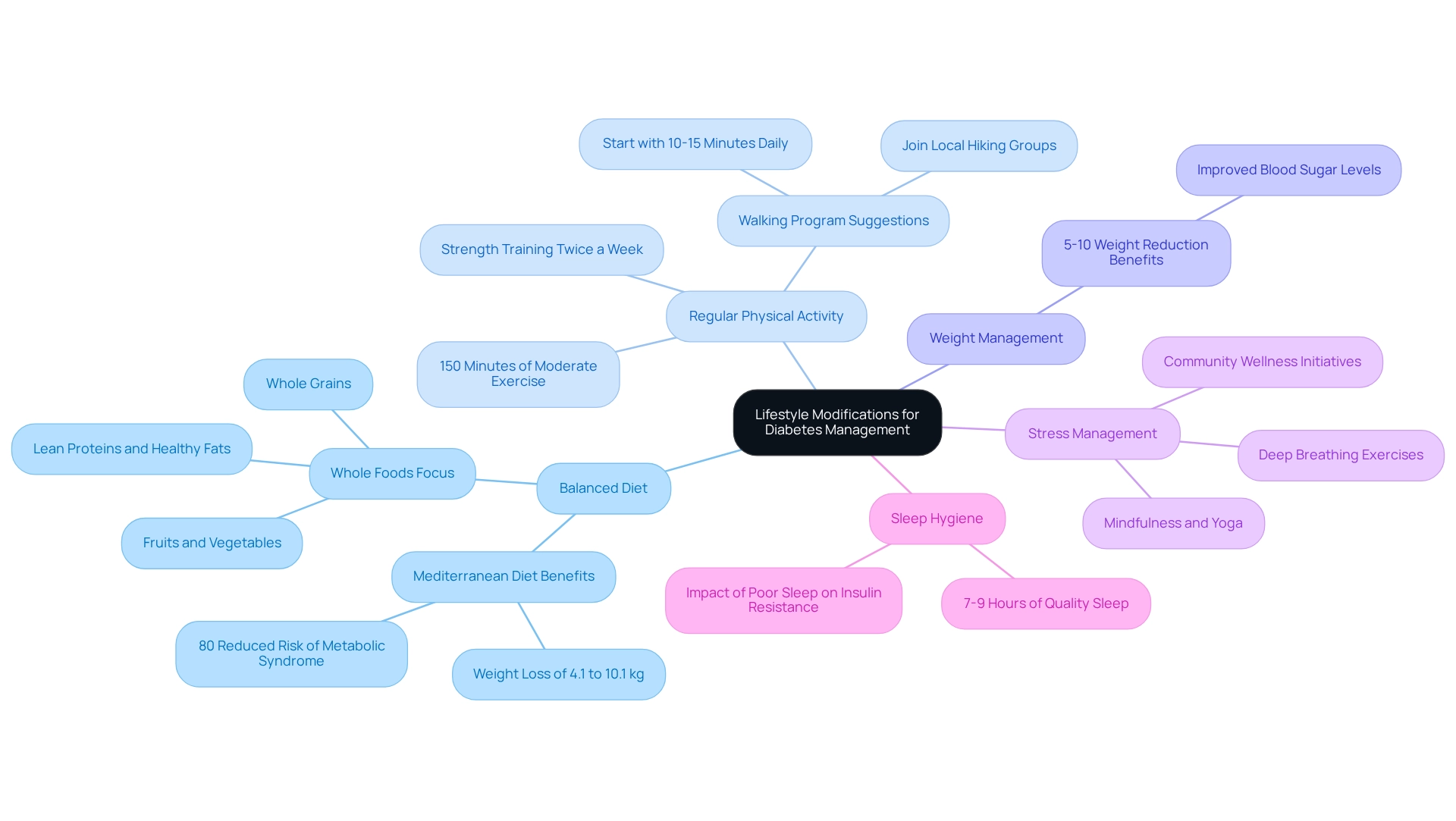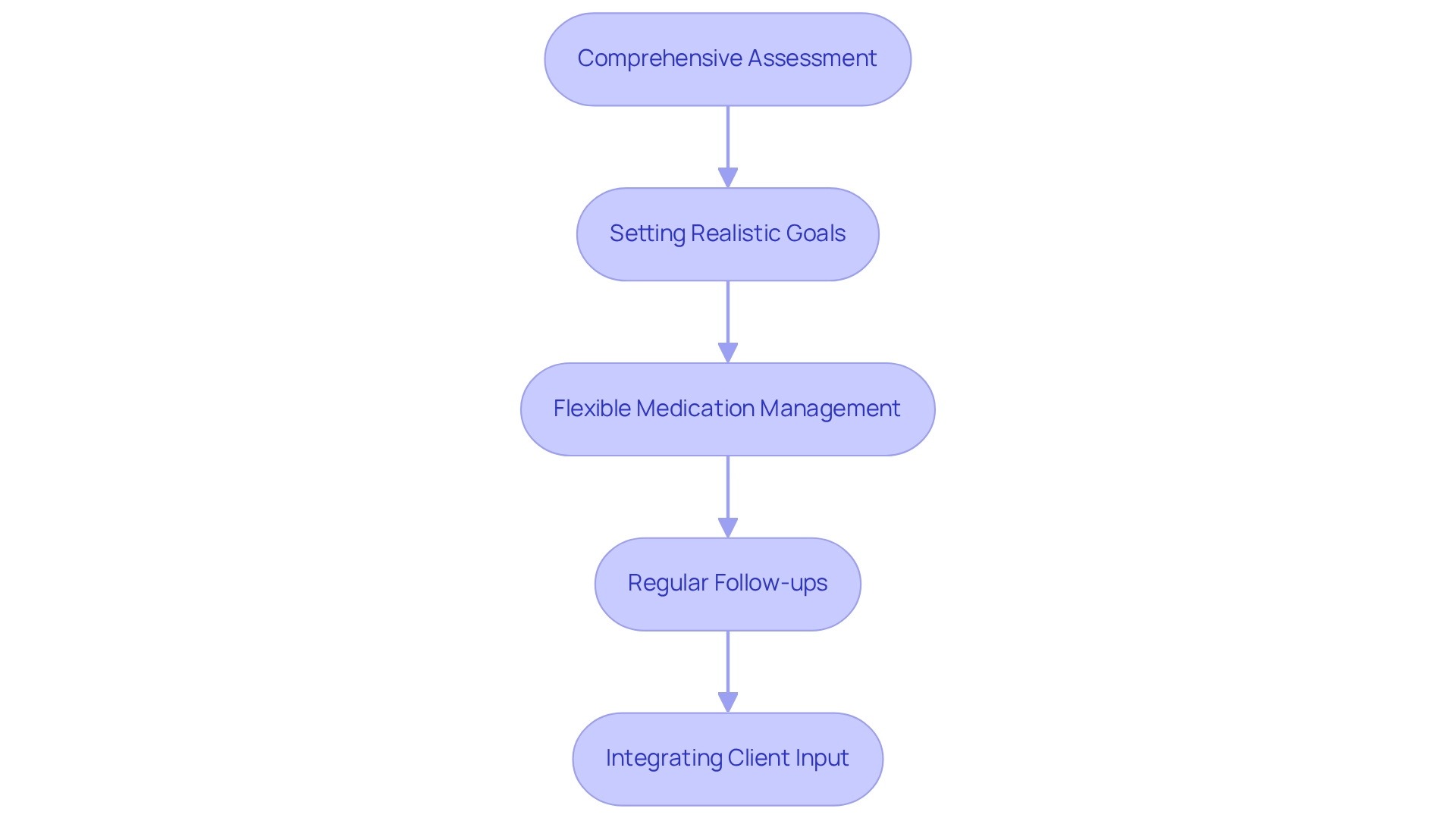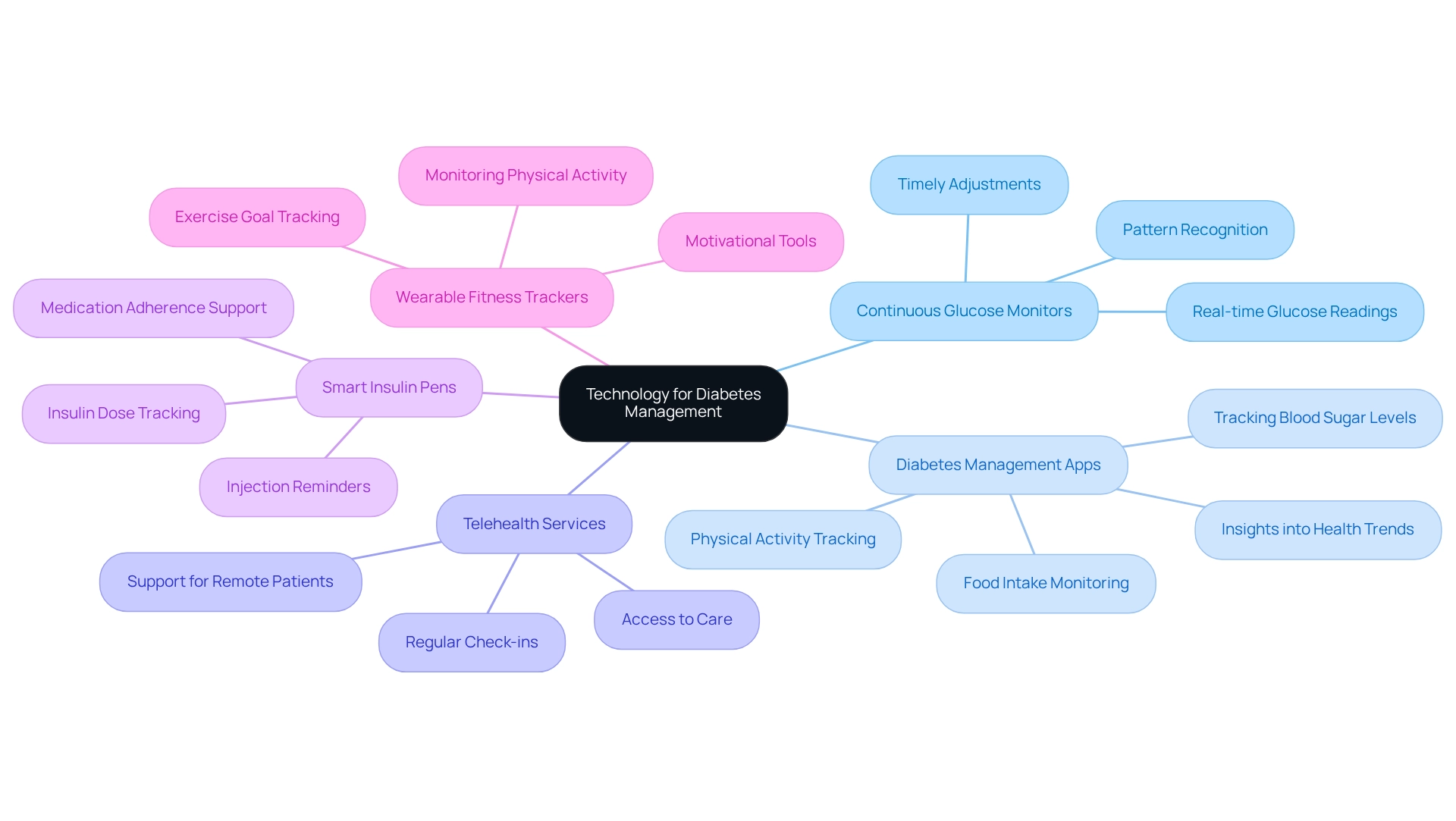Overview
Managing Type 2 diabetes can be challenging, and it’s important to recognize the efforts you’re making. The four key practices that can help you navigate this journey include:
- Implementing lifestyle modifications
- Individualizing treatment plans
- Enhancing patient education and self-management skills
- Utilizing technology for improved monitoring
Many patients find that adopting a balanced diet, engaging in regular physical activity, and practicing stress management can make a significant difference.
Imagine how empowering it would feel to take control of your health with personalized care and the use of digital tools. These strategies not only improve blood sugar control but also enhance overall health outcomes for individuals with diabetes. By focusing on what works best for you, you can create a path toward better management of your condition.
Remember, you are not alone in this journey. There are resources and support available to guide you every step of the way. Embracing these practices can lead to a healthier, more fulfilling life. Are you ready to take the next step toward a brighter future?
Introduction
In the realm of diabetes management, it’s important to recognize that a multifaceted approach is crucial for achieving optimal health outcomes. With the rising prevalence of type 2 diabetes, many individuals find themselves navigating complex health journeys. They often turn to:
- Lifestyle modifications
- Personalized treatment plans
- Technological innovations
From adopting a balanced diet and engaging in regular physical activity to utilizing cutting-edge tools like continuous glucose monitors and diabetes management apps, the strategies for effective management are diverse and impactful.
Many patients discover that by prioritizing education and self-management skills, they can empower themselves to take charge of their condition. This empowerment ultimately enhances their quality of life. This article delves into the essential components of diabetes management, offering insights and practical tips for individuals seeking to improve their health and well-being. Together, we can explore ways to foster a healthier lifestyle and support one another in this journey.
Implement Lifestyle Modifications for Effective Diabetes Management
Managing type 2 diabetes can feel overwhelming at times, but the management of diabetes type 2 through a few essential lifestyle modifications can make a significant difference in your journey toward better health. Here are some compassionate suggestions to guide you:
- Balanced Diet: Focusing on whole foods—think vibrant fruits, colorful vegetables, whole grains, lean proteins, and healthy fats—can be transformative. Have you considered the Mediterranean diet? It’s rich in plant-based foods and healthy fats, and studies show it can significantly improve glycemic control and overall health. In fact, following this diet is linked to an 80% reduced risk of metabolic syndrome over six years. Additionally, groups that engaged in this lifestyle for two years or more lost between 4.1 to 10.1 kg, highlighting how crucial weight control is for the management of diabetes type 2 and blood sugar. If you’re in San Marcos, shopping at local farmers’ markets for fresh, seasonal produce can support your diabetes-friendly diet wonderfully.
- Regular Physical Activity: Engaging in at least 150 minutes of moderate aerobic exercise each week, like brisk walking or cycling, can be incredibly beneficial. Have you thought about starting a walking program? Begin by assessing your current fitness level and setting realistic goals, perhaps a daily walk of 10-15 minutes. Incorporating strength training twice a week can enhance insulin sensitivity and improve blood sugar control. Tracking your progress through a journal or app can keep you motivated, and joining a local hiking group or walking with a friend can make it even more enjoyable.
- Weight Management: Achieving and maintaining a healthy weight is vital. Research shows that even a modest weight reduction of 5-10% can lead to significant improvements in blood sugar levels. This underscores the importance of weight control in the management of diabetes type 2.
- Stress Management: It’s important to recognize that stress can exacerbate insulin resistance. Implementing stress-reduction techniques like mindfulness, yoga, and deep breathing exercises can positively impact your blood sugar levels. Participating in community wellness initiatives in San Marcos can provide invaluable support and resources to help you manage your health while enjoying the beautiful surroundings.
- Sleep Hygiene: Aim for 7-9 hours of quality sleep each night. Poor sleep can lead to insulin resistance and cravings for unhealthy foods, making rest an essential element in controlling blood sugar levels.
By embracing these lifestyle adjustments, you can create a sustainable approach to the management of diabetes type 2. Remember, every small step you take can lead to improved overall wellness and a better quality of life. You are not alone in this journey; support is available, and positive change is within reach.
Individualize Treatment Plans to Meet Patient Needs
Creating individualized treatment plans is essential for effective diabetes management and involves several key components:
-
Comprehensive Assessment: Begin with a thorough evaluation of your medical history, current medications, lifestyle factors, and personal health goals. This assessment should include discussions about your dietary preferences, physical activity levels, and any potential barriers to adherence, as these factors significantly influence your treatment success. It’s vital to understand that diabetes is not just a label; it’s a condition that requires effective management of diabetes type 2 through tailored strategies.
-
Setting Realistic Goals: Collaborate with your healthcare provider to establish achievable and measurable objectives. Instead of targeting significant weight loss right away, focus on gradual changes—such as losing 1-2 pounds per week—that can lead to sustainable results. This approach empowers you to take control of your health journey.
-
Flexible Medication Management: Customize your medication plan based on your reactions and preferences. While some may prefer oral medications, others might lean towards insulin therapy or newer alternatives like GLP-1 receptor agonists, which have shown promise in enhancing adherence and outcomes. It’s important to recognize that conventional treatments may inadvertently increase insulin resistance, highlighting the need for a more holistic approach.
-
Regular Follow-ups: Schedule consistent follow-up appointments to monitor your progress, reassess goals, and adjust treatment plans as necessary. This ongoing support not only promotes accountability but also boosts motivation, which is essential for long-term adherence. Regular check-ins can help mitigate risks associated with hospital-acquired infections and incorrect medications, ensuring a safer treatment environment. Did you know that 7,000 erroneous medications are administered to individuals in hospitals, and 80,000 infections are contracted? This underscores the significance of personalized care.
-
Integrating Client Input: Actively encourage open communication about your experiences and challenges. Your feedback is invaluable for guiding modifications to your treatment plan, ensuring it remains relevant and effective in addressing your unique needs. By acknowledging that each journey is distinct, healthcare providers can develop a more supportive and effective management strategy.
By customizing treatment strategies, healthcare professionals can greatly improve satisfaction and wellness outcomes. Statistics indicate that patients aged 35 and older tend to demonstrate better persistence and adherence to treatment plans, highlighting the importance of tailored approaches. Successful case studies show that hospitals have saved millions by adopting adherence initiatives, emphasizing the financial and wellness advantages of personalized care. Ultimately, a patient-focused strategy not only enhances health results but also facilitates the management of diabetes type 2, empowering you to take charge of your condition. As Dr. Frederic W. Platt, MD, wisely asks, “On a scale of 1 to 10, how confident are you that you can adhere to this treatment regimen?” This question underscores the essential role of your assurance in effectively managing your condition.
Enhance Patient Education and Self-Management Skills
To enhance patient education and self-management skills, consider these compassionate strategies:
-
Organized Learning Initiatives: Establish self-care education programs focused on blood sugar control, covering essential topics like nutrition, physical exercise, medication oversight, and blood glucose tracking. These programs should be engaging and tailored to meet the specific needs of participants, fostering a deeper understanding of the management of diabetes type 2 and its related health care.
-
Utilize Technology: Leverage digital tools, such as apps, journals, and online resources, to offer continuous education and support. For instance, apps that monitor blood sugar levels help individuals identify their patterns and make informed adjustments to their care plans. It’s important to recognize that over 75% of individuals with diabetes are now using Continuous Glucose Monitoring (CGM) systems, especially among younger demographics. This trend underscores the growing role of technology in managing health. The market for blood sugar control technology is driven by increased awareness and government initiatives, making it vital for individuals to stay informed about available resources.
-
Encourage Goal Setting: Teach individuals to set SMART (Specific, Measurable, Achievable, Relevant, Time-bound) goals for their diabetes management. This structured approach not only fosters a sense of responsibility but also enhances accountability, which is crucial in the management of diabetes type 2, motivating individuals to engage actively in their wellness journey. For example, setting a goal to walk 10,000 steps daily or to incorporate more local produce into their diet can significantly improve overall health outcomes. Many patients find that organized goal-setting leads to better performance, highlighting its importance in the management of diabetes type 2.
-
Promote Peer Support: Facilitate support groups where patients can share their experiences, challenges, and successes. Peer support has been shown to increase motivation and provide practical advice for the management of diabetes type 2, fostering a community of encouragement and collective learning. Participating in community wellness initiatives can also offer additional resources for effectively managing blood sugar levels.
-
Regular Assessments: Conduct periodic evaluations of individuals’ knowledge and self-management skills. These assessments can identify areas needing further education and reinforce learning, ensuring individuals remain informed and empowered in their health management. Regularly reviewing progress is essential in the management of diabetes type 2, as it fosters accountability and allows for goal adjustments in response to changing fitness levels.
As Chris Askew, Chief Executive of Diabetes UK, emphasizes, “Effective management of the condition necessitates that a person’s emotional needs are considered alongside their physical care requirements.” By enhancing education and self-management abilities, individuals can gain confidence in managing their condition, leading to improved health outcomes and a better quality of life.
Utilize Technology for Improved Monitoring and Management
Managing diabetes can be challenging, but with the right tools, you can take control of your health journey. Here are some supportive resources to consider:
-
Continuous Glucose Monitors (CGMs): These innovative devices provide real-time glucose readings, allowing you to monitor your levels throughout the day. By recognizing patterns in your glucose variations, CGMs empower you to make timely adjustments to your diet and medication, fostering better control of your condition.
-
Diabetes Management Apps: Using apps designed to track your blood sugar levels, food intake, and physical activity can greatly simplify your management process. Applications like MySugr and Glucose Buddy make data recording easier and offer valuable insights into your health trends, helping you stay informed about your well-being.
-
Telehealth Services: Regular check-ins and consultations through telehealth can enhance your access to care, especially if you live in remote areas or have mobility challenges. This approach ensures you receive continuous support and guidance, which is essential for improving your health outcomes.
-
Smart Insulin Pens: These advanced devices not only track your insulin doses but also remind you when it’s time for an injection. This feature is crucial for maintaining stable blood sugar levels and supporting your medication adherence.
-
Wearable Fitness Trackers: Embracing fitness trackers can help you monitor your physical activity levels. These devices serve as motivational tools, encouraging you to reach your exercise goals and maintain an active lifestyle.
By integrating these technological tools into your management of diabetes type 2, you can gain greater control over your condition. Remember, you are not alone in this journey, and these resources can lead to improved health outcomes and a better quality of life.
Conclusion
The journey of managing type 2 diabetes can feel overwhelming at times. It’s important to recognize that this multifaceted challenge requires a comprehensive approach—one that embraces lifestyle modifications, personalized treatment plans, and the integration of technology. By focusing on a balanced diet rich in whole foods, engaging in regular physical activity, and implementing effective weight management strategies, you can significantly improve your health outcomes. Many patients find that stress management and prioritizing quality sleep further contribute to better glycemic control, underscoring the importance of holistic care.
Creating individualized treatment plans is equally essential. A thorough assessment of your unique circumstances allows healthcare providers to tailor interventions that align with your personal goals and preferences. Regular follow-ups and active feedback foster a supportive environment, ensuring that your treatment remains relevant and effective. This personalized approach not only enhances adherence but also empowers you to take an active role in your diabetes management.
Education and self-management skills are critical components in this process. Structured education programs, the use of technology, and goal-setting techniques provide you with the tools you need to manage your condition confidently. Peer support and regular assessments further reinforce learning and accountability, creating a community of encouragement.
Incorporating advanced technologies such as continuous glucose monitors and diabetes management apps into your daily routine enhances monitoring and facilitates informed decision-making. These tools empower you to take control of your health, leading to improved outcomes and a better quality of life.
Ultimately, a multifaceted strategy that combines lifestyle changes, personalized care, education, and technology can transform diabetes management. By embracing these elements, you can navigate your health journey with confidence, fostering a sustainable approach to living well with diabetes.
Frequently Asked Questions
What lifestyle modifications can help manage type 2 diabetes effectively?
Essential lifestyle modifications for managing type 2 diabetes include adopting a balanced diet, engaging in regular physical activity, maintaining a healthy weight, managing stress, and ensuring good sleep hygiene.
What does a balanced diet for diabetes management look like?
A balanced diet for diabetes management focuses on whole foods such as vibrant fruits, colorful vegetables, whole grains, lean proteins, and healthy fats. The Mediterranean diet, which is rich in plant-based foods and healthy fats, is particularly beneficial and has been linked to improved glycemic control.
How can physical activity impact diabetes management?
Engaging in at least 150 minutes of moderate aerobic exercise each week can significantly benefit diabetes management. Activities like brisk walking or cycling help improve blood sugar control and enhance insulin sensitivity.
Why is weight management important for people with type 2 diabetes?
Achieving and maintaining a healthy weight is crucial because even a modest weight reduction of 5-10% can lead to significant improvements in blood sugar levels.
How does stress affect diabetes management?
Stress can exacerbate insulin resistance, making it important to implement stress-reduction techniques such as mindfulness, yoga, and deep breathing exercises to positively influence blood sugar levels.
How much sleep should individuals with diabetes aim for?
Individuals with diabetes should aim for 7-9 hours of quality sleep each night, as poor sleep can lead to insulin resistance and cravings for unhealthy foods.
What resources are available for support in managing diabetes?
Community wellness initiatives and local resources in places like San Marcos can provide support and resources to help manage diabetes effectively while enjoying the environment.



